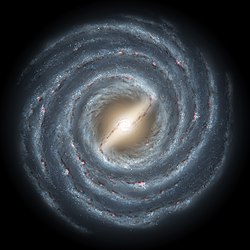Canes-Venatici-II-Zwerggalaxie
| Galaxie Canes-Venatici-II-Zwerggalaxie[1] | |
|---|---|
| Canes-Venatici-II | |
| AladinLite | |
| Sternbild | Jagdhunde |
| Position Äquinoktium: J2000.0, Epoche: J2000.0 | |
| Rektaszension | 12h 57m 10s[1] |
| Deklination | 34° 18′ 15″ [1] |
| Erscheinungsbild | |
| Morphologischer Typ | dSph [2] |
| Helligkeit (visuell) | 15,1 ± 0,5 mag [2] |
| Winkelausdehnung | 3,2±0,6' [3] |
| Physikalische Daten | |
| Zugehörigkeit | Lokale Gruppe |
| Entfernung | 490.000±49.000 Lj. 522.000±16.000 Lj / (150.000 ± 15.000) (160.000 ± 5.000) pc [2][4] |
| Absolute Helligkeit | −4,9 mag [3] |
| Metallizität [Fe/H] | −2,19 ± 0,58 |
| Geschichte | |
| Entdeckung | T. Sakamoto und T. Hasegawa[5] |
| Entdeckungsdatum | 2006 |
| Katalogbezeichnungen | |
| CVn II,[1] | |
Die Canes-Venatici-II-Zwerggalaxie, kurz auch Canes Venatici II, ist eine spheroidale Zwerggalaxie im Sternbild der Jagdhunde. Sie wurde im Jahr 2006 in Aufnahmen der Durchmusterung des Sloan Digital Sky Survey entdeckt[2]. Die Galaxie befindet sich in einer Entfernung von etwa 150 kpc zu unserem Sonnensystem und bewegt sich auf unsere Sonne mit einer Geschwindigkeit von 130 km/s zu.[2][6] Sie besitzt eine ellipsoide Form mit einem Achsverhältnisse von etwa 2:1 und einem Halblichtradius von pc[3].
Eigenschaften
Leuchtkraft
Canes Venatici II ist eine der kleinsten und lichtschwächsten Satellitengalaxien unserer Milchstraße. Die integrale Leuchtkraft entspricht mit einer absoluten Helligkeit von MV = −4,9m in etwa dem 8.000fachen der Sonne, was weniger ist als die Helligkeit eines typischen Kugelsternhaufens.[3] Trotzdem besitzt die Zwerggalaxie aufgrund eines hohen Masse-Leuchtkraft-Verhältnisses von 340 eine Gesamtmasse von etwa 2,5 Millionen Sonnenmassen. Dies impliziert eine für diesen Galaxientyp nicht untypische Dominanz durch Dunkle Materie[6].
Metallizität
Die Sternpopulation von Canes Venatici II setzt sich hauptsächlich zusammen aus älteren Sternen, die vor mehr als 12 Milliarden Jahren entstanden[4]. Die Metallizität dieser altern Sterngeneration ist entsprechend gering mit [Fe/H] = −2,19 ± 0,58, was bedeutet, dass sie in etwa 150 mal weniger an schweren Elementen besitzt als die Sonne[7]. Die Sterne von Canes Venatici II gehören damit wohl zu den ersten Sternen überhaupt, die sich im Universum gebildet haben. Derzeit ist in dieser Galaxie keine Sternentstehung feststellbar, die untere Messgrenze an neutralem Wasserstoffgas liegt bei 14.000 M☉[8].
Weblinks
Einzelnachweise
- ↑ a b c SIMBAD Astronomical Database. Abgerufen am 21. November 2011.
- ↑ a b c d e V. Belokurov, Zucker, D. B.; Evans, N. W.; Kleyna, J. T.; Koposov, S.; Hodgkin, S. T.; Irwin, M. J.; Gilmore, G. et al.: Cats and Dogs, Hair and a Hero: A Quintet of New Milky Way Companions. In: The Astrophysical Journal. 654, Nr. 2, 2007, S. 897. doi:10.1086/509718.
- ↑ a b c d N. F. Martin, De Jong, J. T. A.; Rix, H. W.: A Comprehensive Maximum Likelihood Analysis of the Structural Properties of Faint Milky Way Satellites. In: The Astrophysical Journal. 684, Nr. 2, 2008, S. 1075. doi:10.1086/590336.
- ↑ a b Claudia Greco, Dall’Ora, Massimo; Clementini, Gisella et al.: On the Newly Discovered Canes Venatici II dSph Galaxy. In: The Astrophysical Journal. 675, Nr. 2, 2008, S. L73–L76. arxiv:0712.2241. bibcode:2008ApJ...675L..73G. doi:10.1086/533585.
- ↑ T. Sakamoto, Hasegawa, T.: Discovery of a Faint Old Stellar System at 150 kpc. In: The Astrophysical Journal. 653, Nr. 1, 2006, S. L29–L32. arxiv:astro-ph/0610858. bibcode:2006ApJ...653L..29S. doi:10.1086/510332.
- ↑ a b J. D Simon, M. Geha: The Kinematics of the Ultra‐faint Milky Way Satellites: Solving the Missing Satellite Problem. In: The Astrophysical Journal. 670, 2007, S. 313. doi:10.1086/521816.
- ↑ E. N. Kirby, Simon, J. D.; Geha, M.; Guhathakurta, P.; Frebel, A.: Uncovering Extremely Metal-Poor Stars in the Milky Way's Ultrafaint Dwarf Spheroidal Satellite Galaxies. In: The Astrophysical Journal. 685, 2008, S. L43. doi:10.1086/592432.
- ↑ J. Grcevich, Putman, M. E.: H I in Local Group Dwarf Galaxies and Stripping by the Galactic Halo. In: The Astrophysical Journal. 696, 2009, S. 385. doi:10.1088/0004-637X/696/1/385.
Auf dieser Seite verwendete Medien
Caption from NASA: Like early explorers mapping the continents of our globe, astronomers are busy charting the spiral structure of our galaxy, the Milky Way. Using infrared images from NASA's Spitzer Space Telescope, scientists have discovered that the Milky Way's elegant spiral structure is dominated by just two arms wrapping off the ends of a central bar of stars. Previously, our galaxy was thought to possess four major arms.
This artist's concept illustrates the new view of the Milky Way, along with other findings presented at the 212th American Astronomical Society meeting in St. Louis, Mo. The galaxy's two major arms (Scutum-Centaurus and Perseus) can be seen attached to the ends of a thick central bar, while the two now-demoted minor arms (Norma and Sagittarius) are less distinct and located between the major arms. The major arms consist of the highest densities of both young and old stars; the minor arms are primarily filled with gas and pockets of star-forming activity.
The artist's concept also includes a new spiral arm, called the "Far-3 kiloparsec arm," discovered via a radio-telescope survey of gas in the Milky Way. This arm is shorter than the two major arms and lies along the bar of the galaxy.
Our sun lies near a small, partial arm called the Orion Arm, or Orion Spur, located between the Sagittarius and Perseus arms.



